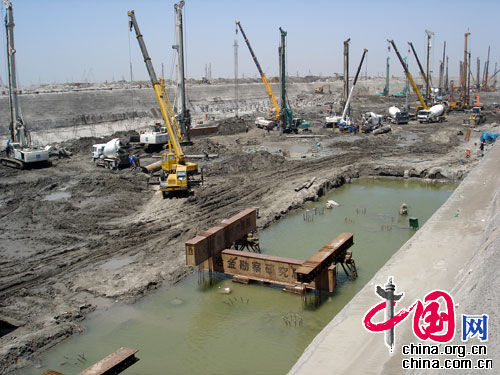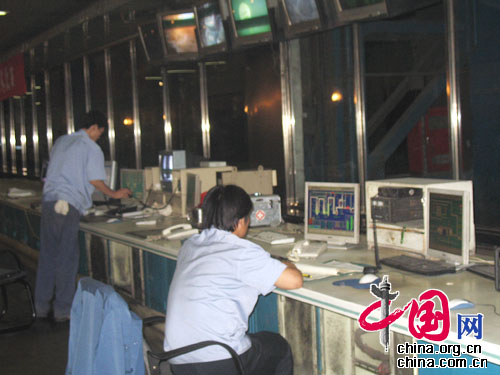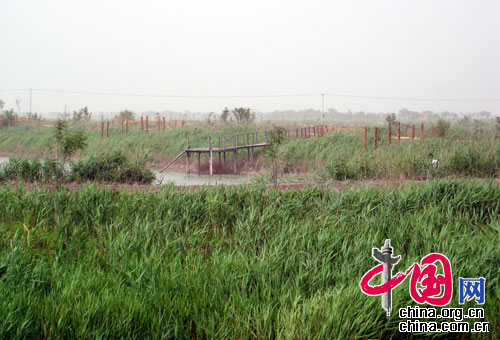| Home / China / Features | Tools: Save | Print | E-mail | Most Read |
| Shougang Transforms Caofeidian |
| Adjust font size: |
Located 80 kilometers south of Tangshan City and embraced by the Baohai Economic Circle, Caofeidian is surrounded by seven provinces and cities including Beijing, Tianjin, and Hebei. As the new site of the Shougang Group, Caofeidian will soon be transformed into a world-class iron and steel production base. The site is rich in natural resources, boasting 4.4 billion tons of iron ore and 5 billion coal reserves. A recently discovered oil field with a reserve of 1 billion tons will also boost the development of the area.
A New Caofeidian in the Pipeline This project is possible due to joint efforts made by Shougang and Tanggang (Tangshan Iron and Steel Group), who hold respectively a 52 percent and 46 percent stake of the investment, totaling 67.731 billion yuan. Officially named Shougang Jingtang Iron and Steel Co. Ltd, it was established on October 22, 2005.
The construction work was inaugurated on March 12, 2007, and is quickly making progress. The initial phase of the production capacity will yield estimated 9.89 million tons of iron, 9.7 million tons of steel, and 9.05 million tons of rolled steel. In 2008, half of the designed capacity is expected to be completed and in 2010 the plant will be fully put into operation. The main task of construction includes two 5,500-cubic-meter blast furnaces, two 300-ton converting furnaces, 2,250-millimeter and 1,580-millimeter hot rolling mills, 1,700-millimeter and 1,550-millimeter pickling cold rolling mills, together with a 250-thousand-ton ore wharf. The new site has adopted a batch of cutting-edge facilities and technologies that will make new Shougang the flagship in the industry in China.
Steel Giant to Move Out of Beijing Chinese steel giant, Shougang Group, currently located in Beijing, will move all of its steel-related ventures out of the city by 2010, the company reports. Its Beijing headquarters will be transformed into an environmentally friendly site that focuses on new businesses. Though the employees feel sad about leaving Beijing, they are absolutely willing to relocate and are now making preparations to do just that. They say the plants are home to them but they are willing to dismantle them and move out of Beijing in order to provide the city with a nicer environment to host the upcoming 2008 Olympic Games.
The group had been unable to find any other sites near its current Beijing location suitable for its enlargement and further development. Furthermore, Shougang finds itself under increasingly high pressure, as the Beijing government sets higher standards of environmental protection. In recent years, it has taken various measures to effectively reduce pollution. Beijing, however, is demanding much cleaner air since it has become the host city of 2008 Olympic Games. Thus Shougang thinks moving out of Beijing in the best interests of the city. So it has decided to find a suitable place for its plants outside the city, finally settling on Caofeidian.
Caofeidian: Industrial Zone 'Built on Sand' Located about 80 kilometers to the south of Tangshan City, Hebei Province, Caofeidian boasts superb conditions for a port basin. Free of silting and freezing, with a 36-meter trough in front and the vast tidal flats in the rear, the island has become the last suitable location for building a large deep-water terminal within the Bohai Gulf. A 300,000-ton terminal was constructed without the need to dredge a channel, making it the best port site in north China and earning it the nickname of a "golden place."
After more than a decade of construction, great changes have taken place in this originally 4-square meter island, with machines roaring and roads extending in all directions. Cascades of sand blown out by suction dredgers look like brown bridges over the water. Cutter-suction dredgers, which transfer sand to restricted waters through huge pipes, can blow out 3,500 cubic meters of sand per hour and turn one square kilometer of water into land every month.
Located to the southwest of Tanghai County in Hebei Province, on the northern shore of the Bohai Sea, the Caofeidian Wetlands Park lies 25 kilometers from the Port of Caofeidian. It is not only the hinterland of the port, but also a hub connecting inland areas with the Caofeidian Industrial Zone, to which the park is expected to serve as a "back garden" in the future. 220 kilometers east of Beijing and 150 kilometers west of Qin Huangdao, the park is a thoroughfare enjoying a favorable location. In the vast tracts of the park, a wide variety of animals and plants thrive in some distinctive ecological zones. Caofeidian is lauded as the only wetland and natural reserve for birds in Hebei Province.
Three features distinguish the park. Covering an area of 11,000 hectares, the large size of the park is an important distinction. Another is the diversity of wetland varieties. The park is a fine example of the integration of natural wetlands with artificial wetlands, boasting nine different types in total, including coastal low beaches and reed ponds as well as rice fields and irrigation canals. The third is its abundance of wild animals and plants. It is home to 238 species of wild plants, including four species of newly-discovered second-grade state-protected plants, ginkgo, lotus, wild soybean, and wild water caltrop. It also boasts 107 species of phytoplankton, 17 species of wild terrestrial animals, 49 species of crustaceans, 63 of mollusks, 286 of insects, 124 of fish and 307 species of birds. Among these, there are 9 species of first-grade state-protected birds such as the red-crowned crane, the white crane and the golden eagle. Additionally 42 other species of second-grade state-protected birds found in Caofeidian are swans, falcons, vultures and eagles. The whole wetland eco-system is a habitat for rare migratory birds, where flocks from over 100 species migrate annually, totaling more than 60,000. The 0.57 hectare forest is well planned with a neatly-arranged tree grid, offering an example of the shelter-forest landscape found in northern China. (China.org.cn July 2007) |
| Tools: Save | Print | E-mail | Most Read |
 |
| Related Stories |




